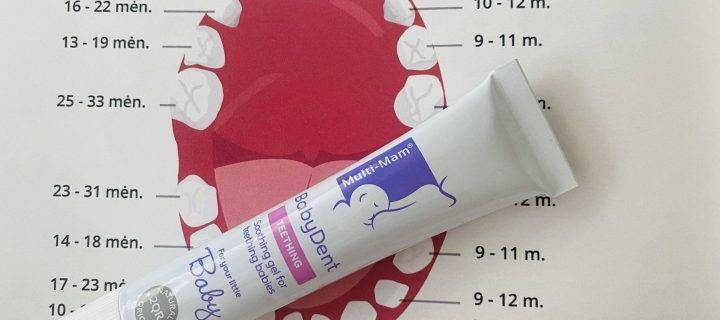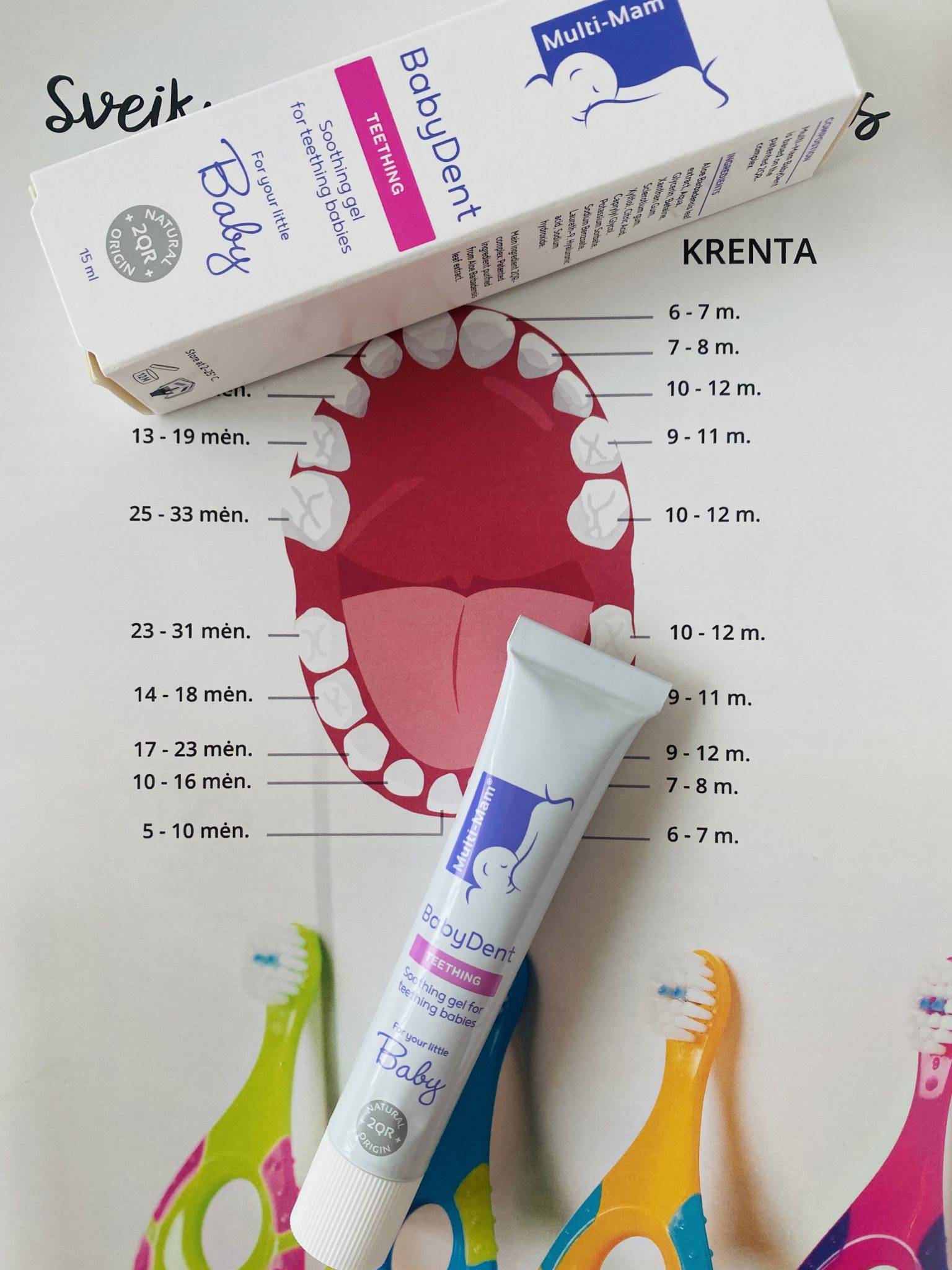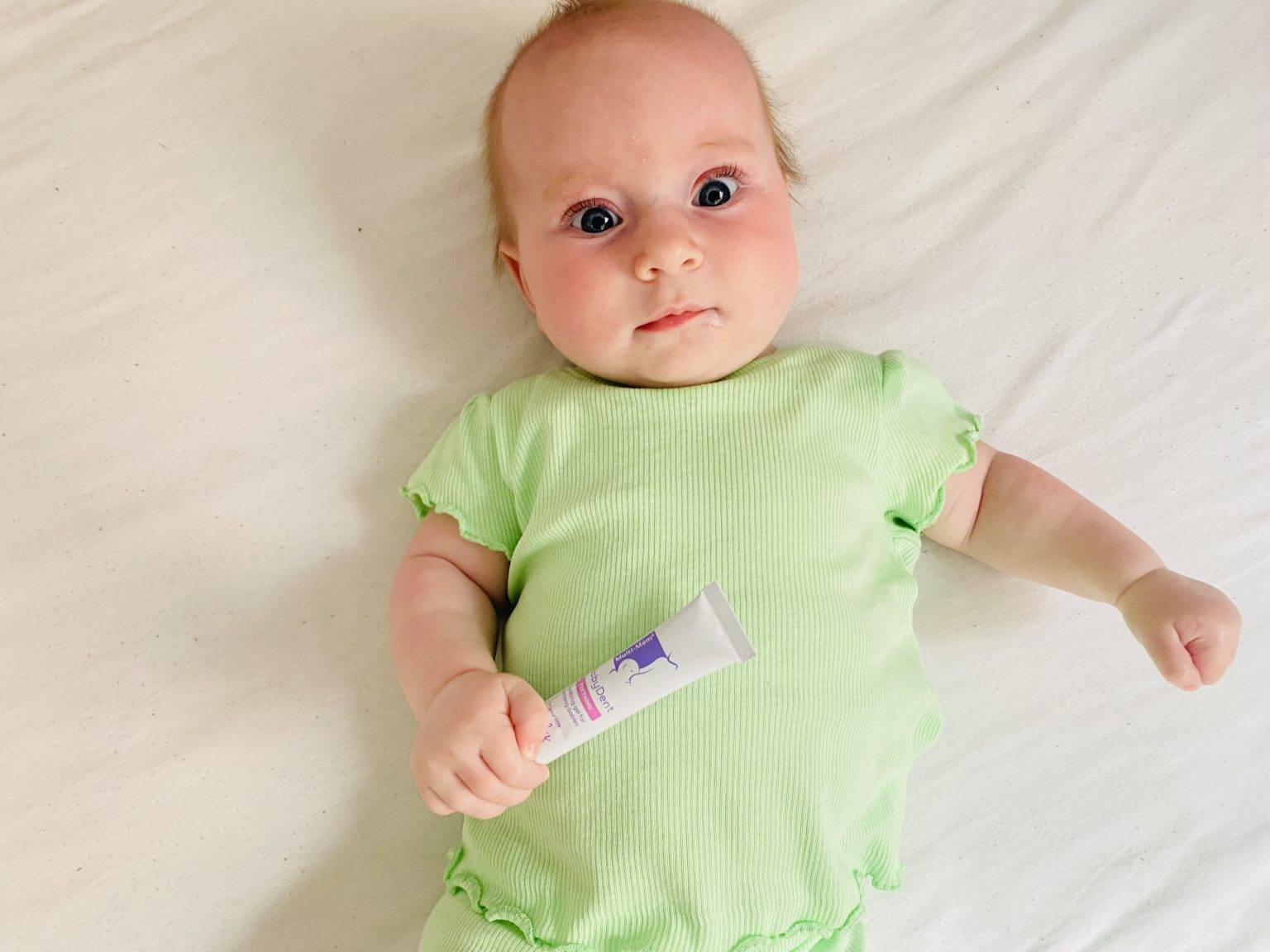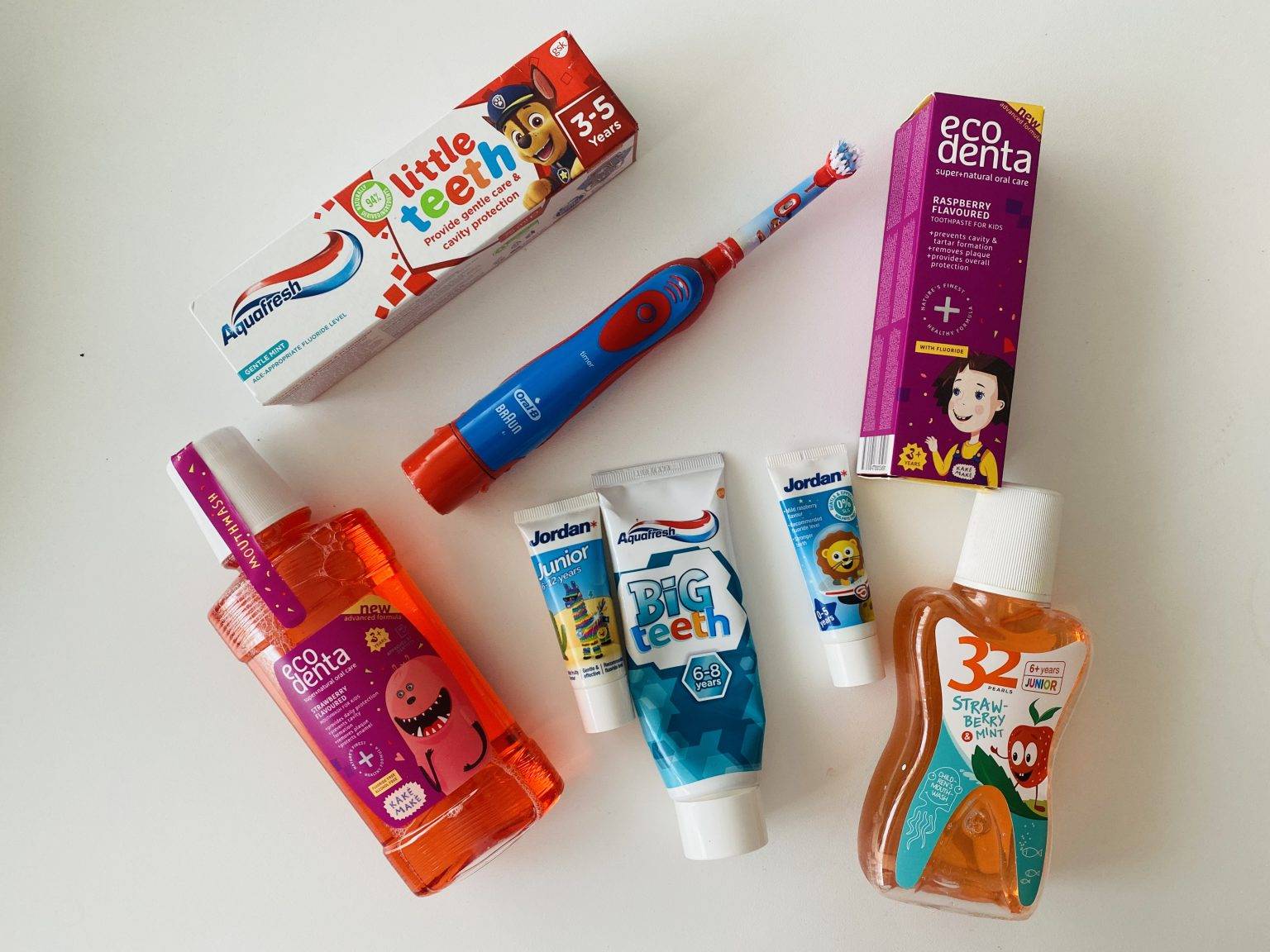Every family with a new baby faces many challenges, one of them being baby teething. Often parents are looking for advice on how to help their little one get through that period as easily as possible. That’s why we share our families experiences, tips and discoveries. One of the “Travel 4 kids” co-founders Agne daughter Paule had her first tooth when she was 5.5 months old, so our experience of baby teething is very new and our tips and recommendations are tried and tested.
Baby teething
How to know that your baby is teething? Approaching 6 months and your baby seems to gnaw on everything in her little hands? Congratulations, your baby’s first tooth are on their way! While for some children the teething process passes unnoticed, unfortunately for the majority of them, they have to endure a lot of pain, itching, and for their parents, sleepless nights.
Usually, babies develop their first teeth around 5-7 months of life, but it can happen that they will develop them much earlier (e.g. at 3 months) or vice versa – the first tooth (maybe even several at once) will come out on the first birthday, as it happened to Greta, the eldest of another founder of “Travel4kids” Jolita. So be careful and patient, they will appear! Newborn babies with missing teeth are occasionally seen, but this is extremely rare. So baby’s first tooth are a topic that can be of interest to parents with babies between three and twelve months.
It is often difficult to distinguish between baby teething and a babies growth spurt that occurs at a similar or even the same time. However, some signs indicate that the first teeth are on their way.
How do I know when my baby is teething?
What symptoms betray that baby’s first baby teeth are on their way and will appear soon? We share the most common symptoms:
- Red, swollen gums at the teeth area;
- Increased salivation – but it’s worth knowing that all babies have a natural increase in salivation around 4 months, as the salivary glands are forming, which is often misunderstood as a desire to eat solid food;
- A baby’s strong desire to bite and stick his fingers in his mouth, when he tries to bite and chew everything within reach – his own and his mother’s fingers, toys, etc.
- Increased irritability;
- More frequent awakenings at night and sleep disturbances;
- Temperature may be elevated;
- Decreased appetite, the baby may refuse food, wanting only the breast or bottle, due to pain, excess saliva;
- Changes in feces, the baby may discharge more feces and more frequently, but this is not true diarrhoea – it is due to excess saliva and a change in composition and a mild inflammatory reaction in the body, as well as objects and fingers constantly being put in the mouth;
- The most painful stage, when the tooth erupts, can last about a week. How a child’s body reacts depends on a number of factors – heredity, health, pain threshold.
10 tips to help your little one with teething
Cold remedies
Try cold remedies to help relieve pain and inflammation symptoms. These can include a variety of teething toys filled with cold water or a merlin that has been chilled for a few minutes in a freezer. Important! NEVER give a child an item that is very cold, especially gel chews, as they can burn the skin or cause sore throats;
Massage
Massage the baby’s gums with a silicone tip, a soft cloth, a cool spoon or just a clean finger;
Medicine
If the child is in obvious pain, give a single dose of ibuprofen or prophylactic homeopathic Viburcol;
Cold food
If the child is already fed, give cooler foods such as cool (but not cold!) berries, fruit purees, yoghurt;
Ointments
Apply a skin regenerating ointment to the chin and around the lips to prevent rashes;
Pain-relieving gels
Use special pain-relieving gels – they contain local anaesthetics that reduce heat and swelling, pain and inflammatory reactions. Although dental gels are short-acting, as saliva naturally washes them off the gums quickly, they make your child feel much better and are therefore recommended for bedtime and mealtimes;
Love
During this difficult time for your baby, do not spare hugs, cuddles, cuddling, carrying and tenderness – as with an adult in pain, what helps the most is proximity, attention, patience, acceptance of needs and unconditional love;
Cradling
Stretchers, walkers and gymnastic balls for gentle cradling have been a tremendous help during these difficult periods. Sometimes it takes a really long time to soothe a restless toddler, so you can listen to music, listen to an audiobook, watch a favourite TV series or go for a longer hike with your toddler in a carrier or stroller;
Taking a walk
In our experience, toddlers benefit greatly from walks in the fresh air. And any fun activity that diverts their attention away from the pain;
Traveling while teething
If the teething happens while travelling or on holiday, great! Chances are that your little one will be so interested in his surroundings that he’ll forget about his teething troubles. So move around as much as possible, spend time outdoors, but also make time for quality and peaceful rest for your little one. Jolita’s eldest, Greta, had her first tooth when travelling in Cyprus. We didn’t really notice any restlessness or unusual behaviour – just an unusual sound when feeding with a metal spoon…
Natural remedies for teething pain
Every mother is looking for cosmetic products that are as natural as possible and harmless to her little one. We are no exception – both Agne and her firstborn, Motiejus, and Jolita and her two premature babies have tried a lot of products in their search for the best and most reliable. That’s why for Paule, Agne tried non-medicinal products first and is very happy to have found “Multi-Mam Babydent”, which has helped.
Although there is a huge choice of teething gels available nowadays, Multi-Mam teething gel was the one that best met our expectations. We both gained confidence in this brand after our births. Both nipple compresses and nipple balm (no need to wash it off before breastfeeding as it is completely natural) have always been great.
Overall, “Multi-Mam” products can be trusted for their naturalness and quality. They are made with the highest quality ingredients, mostly sourced from natural raw materials, and are safe for both mum and baby.
So Multi-Mam Babydent gel and e.g. “Multi-Mam Babydydam” and “Multi-Mam” Nipple Compresses are based on the unique patented 2QR complex (To cure). It is a natural plant ingredient derived from the AloeBarbandenis plant. This special ingredient provides excellent hydration and promotes the natural healing process. Agne used “Multi-Mam” products after giving birth and still uses them today. Jolita also used these products to feed her two prematurely born children, who needed breast milk especially. You can read more about these products in the articles Mum’s basket to the maternity home and Giving birth in Santariškės.
How “Multi-Mam BabyDent” works
“Multi-Mam BabyDent” reduces and soothes unpleasant sensations during teething. This gel coats damaged and swollen gums with a soft, soothing film. The base material is derived from plants and has the unique property of blocking harmful bacteria from attaching to the gums, so it also helps with oral hygiene.
It is quite simple to use: apply “Multi-Mam BabyDent” Gel to sensitive gums when you need to soothe your child’s discomfort during teething. Gently apply a clean, dry, absorbent cloth to your child’s gums to remove excess moisture before applying the gel. Apply the gel to sensitive areas with a clean finger or small soft brush in gentle massaging movements.
For a longer lasting protective effect: try not to give your child a drink for 30 minutes after applying the gel. For a better soothing effect, “Multi-Mam BabyDent” can be stored in the fridge (at a temperature of 2 to 8 degrees) and will have the effect of a cold compress. “Multi-Mam BabyDent” is best found in pharmacies or baby shops. And always compare prices to find out where to buy cheaper.
Another acceptable method of use is to apply a small amount directly to the pacifier or teether where it will come into contact with the sensitive gums. The maximum amount allowed per day is 15 ml (1 tube).
Use in case of increased salivation: apply a small amount of gel to irritated skin around the mouth. As it is a pleasant soft gel, it can be used to soothe and protect the skin around the mouth in cases of increased salivation.
“Multi-Mam BabyDent” is designed to make it as easy as possible for your baby’s first teeth to erupt.
General advice on dental hygiene
Tooth care products:
- Brushing is essential as soon as the first tooth erupts. Until around 3-4 years of age, most children’s teeth need to be cleaned by their parents: although the child may try to brush them themselves, their motor skills and brushing technique are not yet good enough to do it properly.
- Children aged 5-7 are usually able to brush their own teeth – all you need to do is to monitor whether they have done it well. If necessary, finish the brushing the child has started. It is particularly useful to help them finish brushing with a single toothbrush.
- Jolita’s children are now older, aged 7-9, but sometimes ask for help to brush their teeth better and better. They should also be taught how to floss and, of course, how to use a single toothbrush.
- Dentists advise to start using a toothbrush after the first milk teeth have erupted (around 1-1.5 years). The toothbrush should be child-size: soft, with a small rounded head. Until then, we always used a silicone thimble with a toothbrush for gentle clean-up and massaging the gums.
- Older children can now also use an electric toothbrush. If you can’t get a good clean with a regular toothbrush, an electric toothbrush will help. But remember that a regular toothbrush develops the wrist movements of the hands. Our dental specialists jokingly refer to electric toothbrushes as ‘lazy brushes’. But they can certainly be very useful if children are not able to brush with an ordinary toothbrush.
Choosing toothpaste:
- Children’s toothpaste can be used from the age of two. Check with your dentist which toothpaste your child should use – with or without fluoride. Gentle gels are also available for use from the first tooth, but they should be gentle, all-natural and fluoride-free.
- For children up to 3 years of age, brushing with toothpaste containing 500 ppm fluoride should be done only under parental supervision. Toothpaste should only be used to moisten the tips of toothbrush bristles. After brushing, spit out the toothpaste residue, but do not rinse.
- For children aged 3 to 6 years, it is recommended to brush with toothpaste containing 1000 ppm fluoride under parental supervision. The amount of toothpaste on the toothbrush is the size of a pea. After brushing, spit out the toothpaste residue and rinse with a little water.
- For children over 6 years of age, it is recommended to brush with toothpaste containing 1000 ppm – 1450 ppm fluoride. The amount of toothpaste on the toothbrush is 1-2 cm. After brushing, spit out the toothpaste residue and rinse with a little water.
- Many scientific studies have shown that fluoride use reduces the risk of tooth decay. Fluoride strengthens tooth enamel and inhibits acid formation in plaque. Fluoride is involved in the process of enamel repair (remineralisation). It reduces the enzymatic activity of micro-organisms and prevents dental deposits from adhering to the tooth surface.
Visiting specialists:
- Between your first and fourth birthday, you should visit the dentist at least once a year. After your fourth birthday, you should visit the dentist every six months.
- If you suspect any problems, you should not wait until your next visit. Parents often ask, should I fix my decayed baby teeth? Yes, because untreated baby teeth can cause pain and infection, which can damage the permanent teeth.







